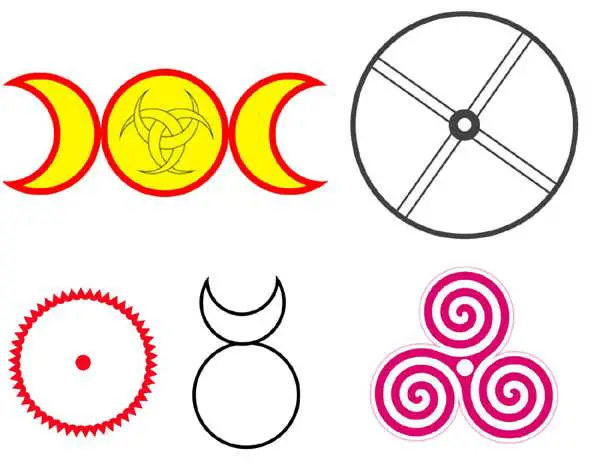The celestial bodies have intrigued man since the primordial times. Our ancestors observed these marvels of nature keenly and used that knowledge to try to understand and explain the workings of their own lives. The Sun and the Moon particularly captivated their imagination and were considered the center of human existence. These awe-inspiring heavenly objects were worshipped by all the ancient civilizations for the mystical powers given to them by the Creator, the amazing phenomena, such as eclipses related to them, and the critical impact they have on human life. Therefore, the Sun and the Moon have long been part of ritualistic and religious practices of different cultures worldwide.
The Sun and the Moon have also come to symbolize different aspects of human consciousness. Considering the unique hold these powerful celestial bodies have always had on man’s psyche, it is not surprising that all the ancient civilizations had developed a number of solar and lunar symbols that have significance in a number of fields, including religion, astrology, mythology, divination, mysticism, semiotics, psychoanalysis and heraldry. Let us take a look at some of the popular solar and lunar symbols.
Solar Symbols
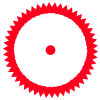 Sun/Circle with a dot: A circle with a dot in the center is an ancient astronomical astrological solar symbol that represents the Sun. In Egyptian hieroglyphs, the symbol is representative of the solar deity, Ra. It is also an alchemical symbol that stands for Gold. Sun/Circle with a dot: A circle with a dot in the center is an ancient astronomical astrological solar symbol that represents the Sun. In Egyptian hieroglyphs, the symbol is representative of the solar deity, Ra. It is also an alchemical symbol that stands for Gold. |
 Sun Cross: Possibly the world’s oldest religious symbol, the Sun Cross appears in American, European, Indian and Asian religious art. It shows an equal-armed cross inside a circle and symbolizes the solar calendar, marking the solstices. It may even be depicted as an eight-armed wheel where the equinoxes are also marked. The Sun Cross is also known as the Solar Cross and Odin’s Cross. Sun Cross: Possibly the world’s oldest religious symbol, the Sun Cross appears in American, European, Indian and Asian religious art. It shows an equal-armed cross inside a circle and symbolizes the solar calendar, marking the solstices. It may even be depicted as an eight-armed wheel where the equinoxes are also marked. The Sun Cross is also known as the Solar Cross and Odin’s Cross. |
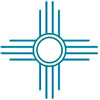 Zia Sun: Depicted as a red circle having four groups consisting of four rays each, all pointing toward the four directions, the Zia Sun is a symbol of the Sun revered by the ancient Zia Pueblo tribe in New Mexico. The Zia Indians also held the number four sacred, and on the sun symbol, the number represents the four seasons, directions and ages of man. The symbol is found on ceremonial vases, pottery, and other artifacts and is also drawn on campfire grounds. Zia Sun: Depicted as a red circle having four groups consisting of four rays each, all pointing toward the four directions, the Zia Sun is a symbol of the Sun revered by the ancient Zia Pueblo tribe in New Mexico. The Zia Indians also held the number four sacred, and on the sun symbol, the number represents the four seasons, directions and ages of man. The symbol is found on ceremonial vases, pottery, and other artifacts and is also drawn on campfire grounds. |
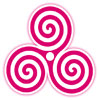 Triple Spiral or Triskele is a tripartite symbol consisting of 3 interlocked spirals. This ancient Celtic symbol is associated with the earthly life, afterlife, and reincarnation. The Triple Spiral is also related to the Sun; a spiral represents the movement of the Sun in three months. Therefore, the Triple Spiral denotes nine months and is considered a symbol of pregnancy. Triple Spiral or Triskele is a tripartite symbol consisting of 3 interlocked spirals. This ancient Celtic symbol is associated with the earthly life, afterlife, and reincarnation. The Triple Spiral is also related to the Sun; a spiral represents the movement of the Sun in three months. Therefore, the Triple Spiral denotes nine months and is considered a symbol of pregnancy. |
Lunar Symbols |
|
 Moon: The crescent moon is a traditional astrological symbol for the Moon and an alchemical symbol for Silver. The Hermetic sciences use symbols to represent the liquid, passive, and feminine. Moon: The crescent moon is a traditional astrological symbol for the Moon and an alchemical symbol for Silver. The Hermetic sciences use symbols to represent the liquid, passive, and feminine. |
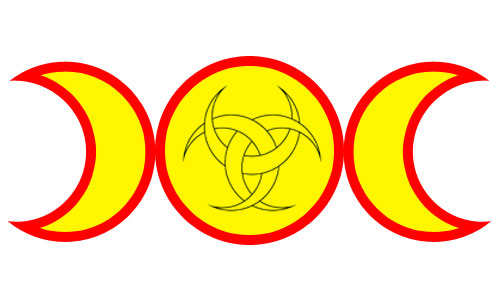 Triple Crescent: The Triple Crescent symbolizes the Triple Goddess and Her tripartite nature. It represents womankind’s three stages: the Maiden, Mother, and Crone. The symbol also signifies the three main aspects of life, which are birth, growth, and death. Triple Crescent: The Triple Crescent symbolizes the Triple Goddess and Her tripartite nature. It represents womankind’s three stages: the Maiden, Mother, and Crone. The symbol also signifies the three main aspects of life, which are birth, growth, and death. |
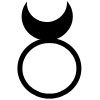 Horned God: The Wiccan Horned God symbol is used to represent the masculine aspect of divinity or the male energy of God, which is equal & opposite to the female Triple Goddess. The symbol combines the images of a full moon and a crescent moon. It is associated with vegetation, wilderness, nature, hunting, fertility, and sexuality. In Dianic Wicca, the Horned God is also used to symbolize Goddess Diana and known as the ‘Horn Moon’. Horned God: The Wiccan Horned God symbol is used to represent the masculine aspect of divinity or the male energy of God, which is equal & opposite to the female Triple Goddess. The symbol combines the images of a full moon and a crescent moon. It is associated with vegetation, wilderness, nature, hunting, fertility, and sexuality. In Dianic Wicca, the Horned God is also used to symbolize Goddess Diana and known as the ‘Horn Moon’. |
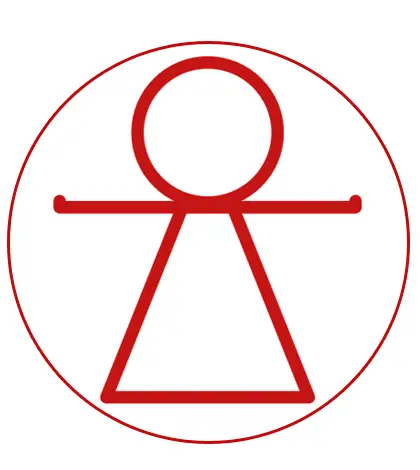 Tanit: Tanit was the Phoenician and Carthaginian Goddess of the moon and is also known as Tannou or Tinnit. The Goddess was invoked for the protection and fertility of the city of Carthage. The symbol of Tanit is very unique and stylized like a human body. It shows a circle on the top of a triangle. A horizontal line separates the figures, and it has upturned vertical bars on both ends. Some consider the circle to be representative of the full moon. Tanit: Tanit was the Phoenician and Carthaginian Goddess of the moon and is also known as Tannou or Tinnit. The Goddess was invoked for the protection and fertility of the city of Carthage. The symbol of Tanit is very unique and stylized like a human body. It shows a circle on the top of a triangle. A horizontal line separates the figures, and it has upturned vertical bars on both ends. Some consider the circle to be representative of the full moon. |

